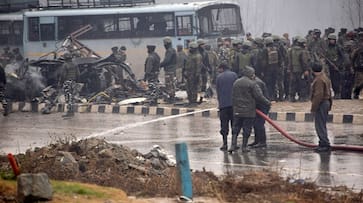Pulwama attack was one of the most ghastly incidents in recent times and this time Pakistan which nurtures the Jaish-e-Mohammad was not going to get away with it. The training facility at Balakot, which produces suicide bombers for the JeM has long been on the radar of the Indian agencies.
New Delhi: One year has gone by since a suicide bomber of the Jaish-e-Mohammad struck at Pulwama in which 40 CRPF jawans were martyred.
It was one of the most ghastly attacks in recent times and this time Pakistan which nurtures the Jaish-e-Mohammad was not going to get away with it. Pakistan had clearly not learnt its lesson, following the surgical strikes in the aftermath of the Uri attacks. This time it was not going to be the same.
The Balakot air strike:
The training facility at Balakot, which produces suicide bombers for the JeM has long been on the radar of the Indian agencies. In fact, an officer with the Research and Analysis Wing told MyNation, that they had been giving out information about Balakot since 2006 and also felt the need to hit it. However, no government was ready to take that decision as it meant flying into Pakistan.
Post Pulwama, when the government discussed measures on how to hit Pakistan, the first choice was a surgical strike. Top officials led by the National Security Advisor Ajit Doval felt that this time the response had to be harder and that is when the suggestion to hit Balakot came up. The Indian Air Force put into motion a plan in quick time, following which the go ahead was given.
During the strike, the IAF hit four buildings at Balakot. The targets were hit by five S-2000 prevision guided munition that were fired from the Mirage 2000. Pakistan confirmed the strike, but denied that any damage was done. However, India provided evidence in the form of Synthetic Aperture Radar, that suggested four targets were hit. The strike only confirmed India’s strong intent and the fact that Pakistan was extremely vulnerable.
Article 370:
The other major decision that was taken was the abrogation of Article 370. While this decision integrated Jammu and Kashmir with the rest of India, it also sent out a strong message to Pakistan that Kashmir was none of its business anymore.
While this decision ensured that Kashmir was entirely India’s internal matter, it was the diplomatic victories that India scored on the international forum that put Pakistan further on the back seat. Even countries such as Saudi Arabia said that Article 370 was India’s internal business. Pakistan, with the help of China, also tried bringing up the issue at the UN. However, smart diplomacy by India ensured that no country even acknowledged Pakistan’s claims on the Kashmir issue.
Wiping out the JeM, Hizbul Mujahideen leadership:
Post Pulwama, there have been scores of attempts by terror groups to stage big attacks. While the Balakot hit did a great deal of damage for the JeM, the problem was that its leadership was almost intact in the Valley. The Indian forces went after the top leadership of outfits such as JeM, Hizbul Mujahideen and the Lashkar-e-Tayiba.
While the entire leadership of the Lashkar-e-Tayiba was wiped out in the Valley six months ago, the last known commander of the JeM, Qari Yasir was killed in an encounter at Tral, Kashmir in January 2020.
On the other hand, the top rung of the Hizbul Mujahideen was also completely decimated. Army officials say that there is only one top terrorist from the Hizbul who remains and he goes by the name, Riyaz Kaikoo. The forces are on him and it would not be long before he too is killed.
Further, post Pulwama, at least 200 infiltration attempts by the terrorists from Pakistan have been thwarted. There have been over 1,500 cease fire violations by Pakistan since Pulwama and all of them were aimed at providing cover fire to the terrorists waiting to infiltrate. However almost, all attempts made by Pakistan to send its top terrorists in have failed.
Terror down:
An assessment done by the Indian Army says that since the Pulwama attack, terrorism in the Valley is down by 45%. Kashmir has witnessed a reduction in local terrorist recruitment by 45% in 2019 when compared to 2018.
This decrease has not only been due to force. The authorities have ensured that the youth do not take up arms. The youth have been engaged in vocational training activities such as hospitality, computer training and mobile repair. These are efforts that have been made to empower the young Kashmiri youth to make a living for themselves in both the organised and un-organised sectors. Army sources said that such initiatives have helped in keeping these youth away from drugs and guns.
Pakistan has over the years pumped in large amounts of money and routed it through politicians and separatists. This money was only being used to pay the youth to take up terrorism and indulge in stone pelting. However, the new initiatives that India has come up with is gradually luring the youth into doing something more creative so that they can earn money and follow the right path. This way, these youth would shun terror, drugs and also creating law and order problems in the Valley.
Last Updated Feb 14, 2020, 4:50 PM IST









![Salman Khan sets stage on fire for Anant Ambani, Radhika Merchant pre-wedding festivities [WATCH] ATG](https://static-gi.asianetnews.com/images/01hr1hh8y86gvb4kbqgnyhc0w0/whatsapp-image-2024-03-03-at-12-24-37-pm_100x60xt.jpg)
![Pregnant Deepika Padukone dances with Ranveer Singh at Anant Ambani, Radhika Merchant pre-wedding bash [WATCH] ATG](https://static-gi.asianetnews.com/images/01hr1ffyd3nzqzgm6ba0k87vr8/whatsapp-image-2024-03-03-at-11-45-35-am_100x60xt.jpg)


